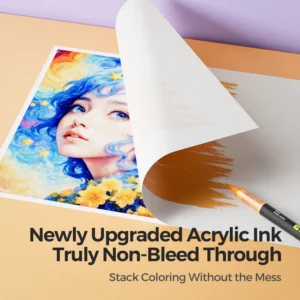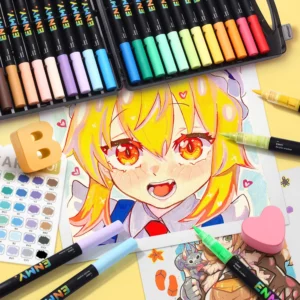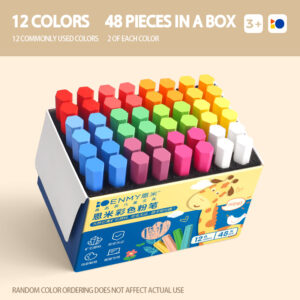The uniqueness of acrylic markers lies in their specialized ink formulation. These markers primarily use acrylic resin as a binder, combined with pigments, solvents, and additives. Acrylic resin is renowned for its quick – drying, waterproof, and weather – resistant qualities. Once dry, the ink forms a durable film that resists fading, water damage, and UV radiation, ensuring vibrant colors over time. Unlike watercolor markers that smudge when wet or alcohol – based markers prone to evaporation, acrylic marker ink solidifies into a stable coating. This grants it exceptional coverage, allowing colors to stand out even on dark surfaces.
Nib design is another highlight of acrylic markers. Common types include fiber tips, chisel tips, and round tips. Fiber tips offer flexibility for precise line work and detailed illustrations; chisel tips enable variable line widths by adjusting the angle, ideal for large – scale coloring and bold lettering; round tips strike a balance, suitable for a wide range of applications. Additionally, high – end models often feature multi – hole nib technology, ensuring consistent ink flow and preventing issues like ink skipping or pooling.
Acrylic markers’ most remarkable strength is their versatility across materials. They perform flawlessly on paper and adhere effectively to wood, ceramic, glass, metal, plastic, and more. Whether you’re upcycling furniture, customizing mugs, decorating bullet journal covers, or personalizing phone cases, these markers expand artistic horizons beyond traditional canvases.
In terms of color performance, acrylic markers excel with high – pigment ink that delivers intense, vivid hues. Their true creative edge lies in color layering and blending capabilities. Artists can build depth through multiple layers or achieve seamless gradients using wet – on – wet techniques, unlocking endless possibilities for color expression.
Compared to traditional acrylic paints, acrylic markers offer unparalleled convenience. Eliminating the need for palettes, brushes, and cleaning supplies, they enable spontaneous creation at any time. Their rapid – drying feature is a boon for efficient workflows, allowing artists to progress to the next step without extended waiting periods.
In illustration, acrylic markers shine for crafting detailed, richly – colored works. Illustrators leverage their precision for outlining characters and textures and use their high coverage to refine highlights and shadows. In bullet journaling and DIY projects, these markers add artistic flair to pages, cards, and handicrafts.
In industrial design and product customization, acrylic markers serve as essential tools for rapid prototyping and sample coloring. Artisans use them to create unique patterns on leather and fabric, producing one – of – a – kind pieces. Their weather resistance also makes them popular among street artists, ensuring outdoor murals withstand harsh conditions.
While user – friendly, mastering a few techniques can elevate your creations. Always test colors on scrap paper first to understand the nib feel and ink behavior. On non – paper surfaces, apply a primer for better adhesion. For smooth blending, work with semi – dry ink. Remember to cap markers immediately after use to prevent drying and store them tip – down for consistent ink flow.
Acrylic markers redefine artistic boundaries with their unique features, broad applicability, and ease of use. Whether you’re a professional exploring new mediums or a beginner expressing creativity, these markers empower inspiration. As technology advances, acrylic markers are poised to revolutionize the art world, fueling innovation for years to come.





